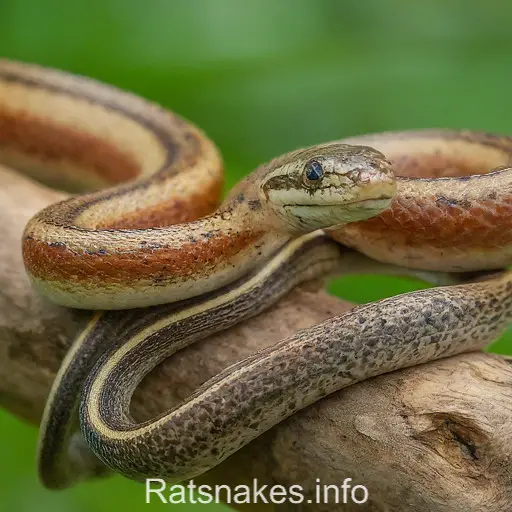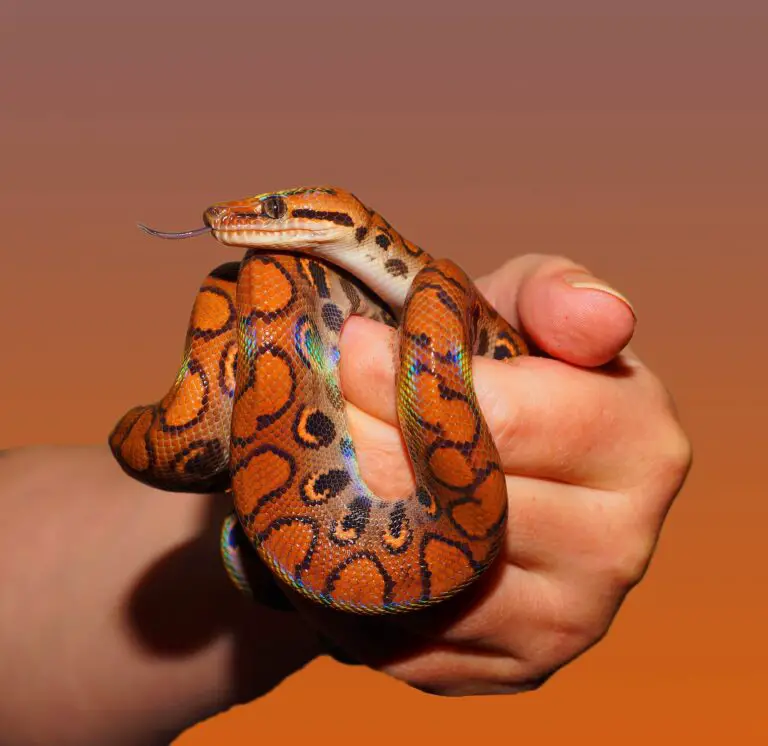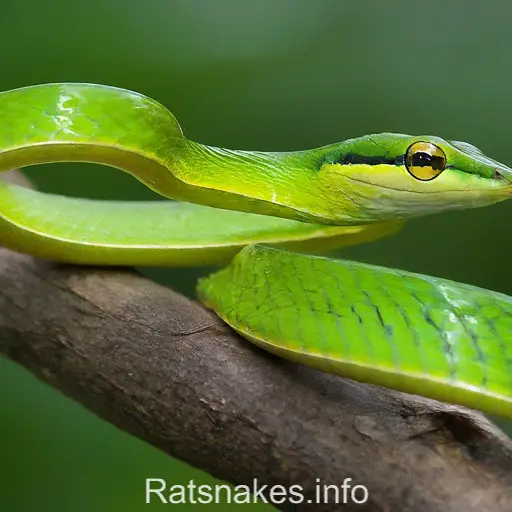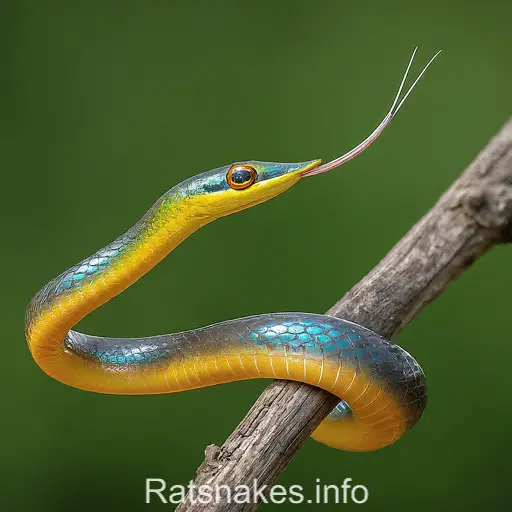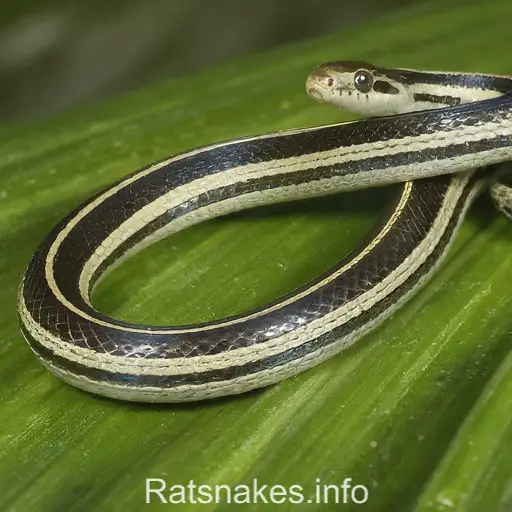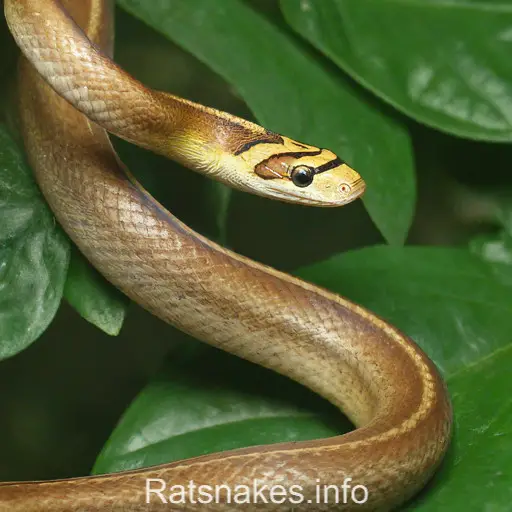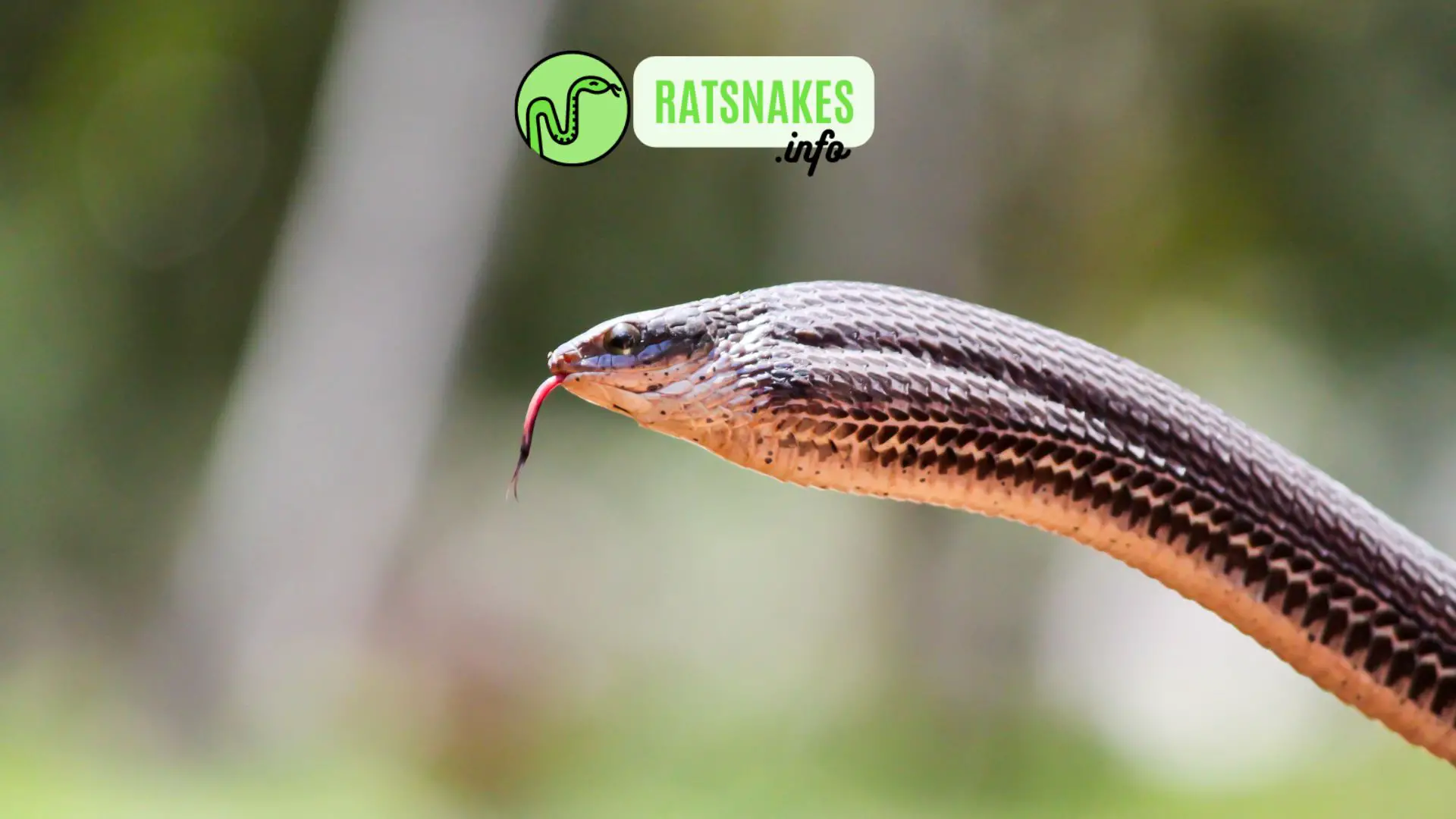
Hissing Sand Snake (Psammophis sibilans)
A Note on Names
Description
Psammophis sibilans is a small to medium-sized Psammophiine snake that can reach a length of about 140cm but is usually somewhat smaller. The body is slim and elegant, the head well set apart from the narrow neck. The head is fairly elongated and the eyes large with round pupils. The tail is relatively long and attenuate.
This is a variable species and demonstrates polymorphism, with animals from the same locality (and even the same clutch) displaying different colours and patterns. Generally the body is greyish or brownish with a cream or yellow vent. Specimens received from Egypt by the author have had cross bars or been uniformly coloured, or displayed two to four longitudinal stripes running from the nape of the neck to the tail. The vent may also have a pair of thin brown lines running the length of the body, or be uniform.
General coloration can vary over the (wide) range; this species is found throughout Africa, with the exception of the north-western and southernmost regions, but are not present in tropical forests and tend to be replaced by species such as P. schokari in true desert. Specimens received by the author from Tanzania displayed a slightly different head shape and a very reddish, almost “mahogany” brown colour on the dorsum.
Some breeding males have been seen to develop brighter colours, such as an orange throat and yellow cross-bars on the nape of the neck. Like some other Psammophiine snakes, P. sibilans possesses nasal glands for use in “rubbing behaviours.” The secretion produced has a high lipid content and this has been hypothesised to help stop moisture loss through the skin or possibly for use in the delineation of territories; several Psammophiine genera display a relatively complex social hierarchy , forming territories, pair bonds, and exhibiting “rubbing” behaviours (the purpose for which is as yet unknown).
Psammophis sibilans displays this “rubbing behaviour” on itself, by rubbing its belly and flanks, and also has been witnessed by the author to rub other snakes and even certain features in the terrarium, although it was not clear if this was intentional or not in the case of the former (the snakes were coiled together; the animal may have mistaken the other snake’s body for its own?).
A high percentage of individuals in populations can show damaged tails or even completely lost tails. This is not true autotomy (as in some lizards) but is due to this species’ propensity to spin wildly when grasped by the tail, thus causing the break; the tails do not grow back.
Acquisition and Acclimation
Despite being one of the more common snake species in many areas in which it is found, this snake is not often seen for sale in the UK. However, it is occasionally available from dealer’s lists and it may be possible to have them ordered in by pet shops willing to do so.
This is a tough, undemanding species and all the new imports I have received have arrived in very good condition. I attribute this not just to reputable importers, but also to the fact that these snakes come from arid regions and naturally experience wide variations in temperature; the other benefit of coming from a dry region that is generally more inhospitable to possible parasites than other more humid climates, is that treating these snakes is generally problem-free.
Handling
These snakes are initially extremely nervous and flighty but after some weeks or months will voraciously take food from forceps. They do not like being handled and will wriggle wildly, spin in the grip, musk and attempt to bite. The bite is mildly venomous (this species was on the DWA list until 2007) but not considered dangerous; the venom glands are large, however. A bite I received from a wild specimen in Egypt resulted in rapid inflammation to my wrist but no other symptoms; the swelling had subsided by the following morning.
Some animals can calm down considerably after several weeks, whereas others remain nervous and unmanageable. Gloves are recommended when it is necessary to pick these snakes up.
Psammophis sibilans has to rate as one of the fastest, most difficult to catch snakes I have ever worked with, putting species such as Radiated Rat Snakes, Flying Snakes and many Whip Snakes to shame. They can unexpectedly explode forwards from a stationary position with startling rapidity, are prone to “jumping” from the keeper’s grip or out of a top-opening box, and will spin and thrash wildly when restrained.
Even “tame” specimens can suddenly and unexpectedly become flighty, and an escaped snake on the floor can be difficult to recapture – it is wise not to have this species in a room where there is the possibility of the snake getting into cracks, holes or other places from which it would be difficult or impossible to recapture the animal in the event of it escaping the keeper’s grasp.
These snakes do not enjoy being handled; at best calmer specimens will tolerate it, but they are basically a species best enjoyed by viewing them in their enclosure.
Housing
In captivity this is a very easy species to keep, requiring only dry, warm conditions. They do not tolerate long periods of dampness and must be kept dry at all times. A small water bowl is necessary, although they will rarely if ever be seen to drink from it. They require warm temperatures with a large drop at night to room temperature.
As with all snakes there are two schools of thought when housing this species. They can thrive perfectly well in a “rack” type system, although as stated they find it very easy to leap out of a top-opening box and will regularly attempt to dive out when it is opened.
However, to really experience how active and interesting this species can be, a more naturalistic, large enclosure is recommended. This is a fast-moving, active and inquisitive species, and will really appreciate a larger terrarium in which to rove and explore. In this way they will provide the keeper with hours of entertainment, and perhaps some of the interesting behaviours for which they are becoming known.
A long terrarium is recommended; not less than 48” and preferably more to really appreciate the snakes’ movements and activity. For obvious reasons a side-opening door is best. Being a semi-desert species, these snakes relish bright light; I use a combination of Repti-Glo 10.0 and Hagen Life-Glo 2, with a spotlight at one end of the setup for a basking area. The fluorescent lights are left on for 14 hours a day; the spotlight for 12 hours.
Good ventilation is needed, so that a hot spot of 32C or more can be provided without fear of overheating the rest of the enclosure, and a thermal gradient down to about 24-25C is created. No heating is provided at night. The snakes will be seen to spend much of their time basking, and then moving into the cooler areas to explore, before returning to bask some more.
A period of mild cooling (about 5-6 weeks) is provided around October/ November, with the spotlights not turned on. The lights are left on for 8 hours a day during this period.
This snake will climb readily into branches and over rocks, but it is also good to provide large open areas for them to traverse, as they are primarily a terrestrial species. A fake rear wall will give them an added dimension to explore. Good terrarium ornaments are pieces of banana root, various rocks and dried grapevine. The substrate used is a mixture of potting soil and sand, in a roughly 50:50 ratio. The best way to check to see if the mix is right is to poke a finger into it and see if the hole remains or is filled in; a good consistency should allow the retention of burrows.
It is possible to keep this species in small groups, but as their prey in the wild includes smaller snakes, it is advised that only specimens of similar size are housed together; in addition, having more than one of these very fast-moving snakes to contend with when servicing the enclosure can become difficult if they are all trying to escape, so caution is advised. However, in this manner some interesting social interactions between individuals can be witnessed, such as the snakes “grooming” one another with the nasal glands. Females will coexist happily but mature males are territorial and will fight if kept together. A ratio of 1.1 or 1.2 is recommended if they are to be co-habited.
Feeding
In the wild these snakes are dietary generalists, taking lizards, smaller snakes, rodents and small birds. In captivity these snakes prove not fussy and readily accept frozen and thawed rodents of the appropriate size. Getting them to feed is not a problem; many will accept prey from forceps within days of being acquired, others may only take food left overnight at first, but these snakes will usually calm down enough that they will approach the keeper to accept food from forceps. They will also take quail chicks.
This is an active species that has a high metabolism and requires feeding more regularly than most snakes. The author prefers several small feeds at regular intervals, usually every 5-7 days; the snakes seem to manage smaller prey better than large prey items. The snakes will feed gluttonously on this regimen and very rarely if ever will miss a feed.
Breeding
After a period of cooling, upon the advent of longer lighting periods, mating was observed which resulted in 10 very rounded eggs being deposited by one of the females. The eggs were incubated in a plastic tub half-filled with water, that was heated by an aquarium heater. The eggs were suspended above the water on tights and a temperature of 28C was used. This resulted in hatchlings after 61 days.
The neonates did not accept pinkies at first but readily assist-fed on pinky parts and pieces of chopped mouse tail. Several of them were also observed to stalk and devour crickets placed into their tubs. Fed in this way every 2-3 days, they eventually came around to voluntarily taking f/t whole pinkies. At this point raising them became unproblematic for the most part.
The babies were kept in Spartan enclosures; paper towel was considered too absorbent and retained too much moisture for them, so plain printer paper was used. Old socks (!) were used for hides, into which the babies eagerly hid, with their heads often peeking out of the mouth to take in their surroundings.
Other Species
Psammophis schokari is also occasionally available from Egyptian shipments. It is a long, slender species, even more slender than P. sibilans, with very large eyes. It is coloured a sandy brown to gold, sometimes with a series of stripes or lengthwise bands down the dorsum, and sometimes uniform. The uniform specimens (many of which belong to subspecies aegypticus) supposedly come from drier areas, and the striped ones from more vegetated locales. The vent is cream, with a pale grey line down the middle bordered by darker lines. The throat of some individuals is spotted.
From its slender, slight appearance it might first be imagined that this is a devout lizard eater, but in fact the three specimens owned by the author took defrosted pinky and fuzzy mice from the outset of their captivity. In the wild this species often takes small passerine birds on migration, and may fast for extended periods between migrations. They are found in drier habitats than P. sibilans; the subspecies P. schokari aegypticus (which some authorities consider a full species) is found in absolute desert with no vegetation.
P. schokari seems shyer than P. sibilans and don’t accept the keeper as readily as the former species, but will eagerly take prey that is left in the enclosure with them. This species readily displays the “periscoping” behaviour and is just as fast-moving and difficult to hold as P. sibilans, although they seem unwilling to bite.
Psammophis phillipsi has been imported from Tanzania; four specimens owned by the author were both less shy than either the above species and also surprisingly docile. In conformation they are very similar to P. sibilans, although stouter and somewhat duller in appearance, being a greyish/ olive brown (in fact bearing more than a passing resemblance to a small Black Mamba) and are similarly easy to keep. The underside of this species is speckled upon cream. The animals I acquired have made very trusting and undemanding pets.
There are many other Psammophis species throughout Africa; some of the smaller species would appear to be more devout lizard eaters and may be somewhat harder to keep due to this preference, but most of the middle-sized to large species in the genus should require similar care to that described above as a starting-point.
Conclusion
Unfortunately a very overlooked genus, despite the fact that the species named above make hardy, undemanding and very interesting captives. They are inquisitive, active and entertaining snakes that are really set off by a well designed desert vivarium, and provide interesting behaviours not seen in other snakes. Hopefully in the future there will be more successes inspired by the trickle of captive-bred specimens being born to a handful of devout enthusiasts recently.

